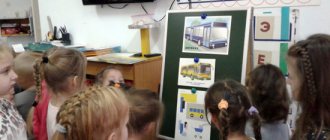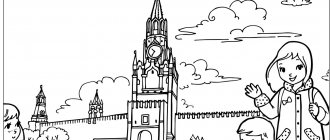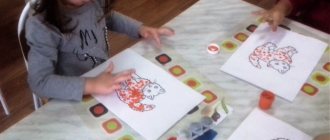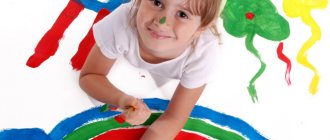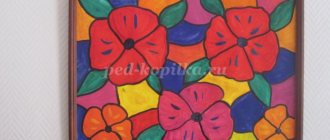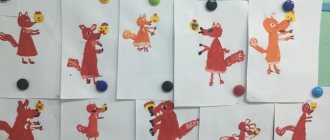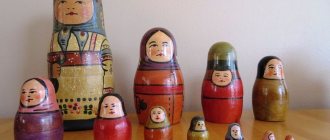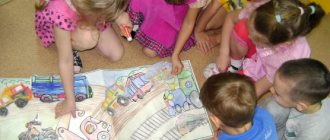Preparing for a drawing lesson on the topic “My favorite fairy tale”
Children of the sixth year of life show diligence and fantasize in art classes. Drawing on the theme “My Favorite Fairy Tale” involves depicting animal characters. The guys will study the proportions and poses of the human body later. The purpose of the lesson is to convey the image and character of a fairy-tale hero in a drawing.
Children convey their impressions of the fairy tale they heard in drawings.
Educational tasks are aimed at developing children’s artistic skills:
- Improving drawing techniques: with a brush: drawing lines, strokes, shapes, shading with the tip of the brush and drawing details, filling the background,
- pencil: drawing a sketch, shading with different pressure.
In the older group, children are given the right to choose materials: paints or pencils
Paints and base for painting
- Watercolor - for painting the background.
- Gouache - for drawing a composition.
- Felt pens - for tracing the contours of the drawing.
- Brushes of different thicknesses.
- Colored pencils, simple - for preliminary sketching.
- A4 sheet - thick white paper.
Children love felt-tip pens for their brightness. For my daughter’s 5th birthday, she was given a large suitcase—what colors and shades of felt-tip pens were in it. The child drew only with them at home. In the summer I took my suitcase with me to the dacha. And in September I was upset in class. Not because there are no markers in the kindergarten, but my hand has lost the habit of drawing with a pencil.
Drawing with felt-tip pens is acceptable in kindergarten, but the main focus is on drawing techniques with paints and pencils
Drawing techniques
- Drawing with a simple pencil:
- Drawing with colored pencils: drawing a sketch with a simple pencil,
For the lesson “Simple and Golden Testicles,” classical drawing techniques can be combined with non-traditional techniques.
- Painting over the sketch with wax pencils or pastels.
- The use of monotype in background painting: imprinting colors adds a fantastic atmosphere to the drawing.
- Drawing with unusual tools: cotton swabs, plastic fork, sponge, semolina.
A classic painting with paints can be supplemented with dots, for example, using a cotton swab
Combination with other types of visual activities
Incorporating elements of modeling and applique into the work helps to attract children's attention to productive creativity. Pupils of the senior group independently plan how to complement the drawing. For example, lay out the feathers of the firebird with an applique of colored or foil paper. An interesting idea is to lay out a pattern on the clothes of the characters or partially the background with plasticine parts.
Children independently choose materials for appliqué from the reserves of waste and natural materials in the creative corner:
- cereals and seeds,
- napkins, cotton balls and disks,
- beads, rhinestones,
- pieces of colored paper, wallpaper, magazines.
You can detail the drawing of a fairy-tale hero using a cut-out applique
Task differentiation
The need for multi-level tasks arises when the teacher has identified children with high abilities among the students. Talent requires implementation. A gifted student will complete an ordinary task faster than others and will become bored.
Examples of complicated tasks in the lesson “My Favorite Fairy Tale”:
- Work out the background in detail,
- draw background objects,
- draw elements of folk ornament on the hero’s costume,
- draw a scene (“Kolobok on the fox’s nose,” for example).
Individual tasks for drawing fairy tales are aimed at maintaining and developing talent
Place of the lesson “My Favorite Fairy Tale” in the drawing card index
The theme “My Favorite Fairy Tale” has wide scope for children's creativity. In kindergarten, it is not advisable to give children free topics for drawing. The program for visual arts by T. S. Komarova includes classes “Fairytale Houses”, “Fairytale Bird”, “Fairytale Plot” (based on the fairy tale about the fox and the hare). If the topic does not specify the object of drawing, the teacher carries out preliminary work.
At NOD classes, children study folk and original fairy tales, act out scenes based on them in the theater corner, and play with figurines or character masks.
Thus, the lesson “My Favorite Fairy Tale” will become the final work: children will choose which of their familiar characters to portray.
Without first studying/rehearsing fairy tales with children, the task “Draw your favorite fairy tale” can confuse the children. Alternatively, they will start drawing their favorite characters, but from films and cartoons.
In the theater corner, children act out the plots of fairy tales and get to know the characters better
A creative activity based on fairy tales can be part of a project activity.
- The short-term project involves conducting classes in educational arts and fine arts, role-playing games and dramatizations of fairy tales.
- The long-term project is being implemented through an in-depth study of the topic (“Russian folk tales about animals”, “Tales of A. S. Pushkin”, “Tales of C. Perrault”). A trip to a children's theater or a fairy tale museum is organized. Parents are actively involved: they help sew costumes for the production of the fairy tale, make scenery, and design the poster.
The final event of a project on fairy tales can be an exhibition of drawings
In the older group, children should be encouraged to engage in collective activities. Children can create plot compositions from several characters and with a rich background.
The first lesson on fairy tales is devoted to individual drawing of fairy-tale characters. In the second lesson, the guys study composition.
Children are encouraged to independently think through the sequence of work and distribute tasks among themselves. The teacher directs the idea in the right direction and prompts.
Pupils of the senior group actively interact with each other and create together
A collective drawing composition is created in several stages:
- tinting the paper base,
- drawing background objects,
- consolidation of individual drawings into a plot whole.
Traditionally, a sheet of Whatman paper is used as a basis. We ask parents to bring leftover wallpaper to kindergarten. Children draw on the back of the roll, the paper does not get wet, and straightens out more easily than what paper.
The plot composition on the theme “Fairy Tales” can be supplemented with elements of appliqué and plasticineography
On the topic: methodological developments, presentations and notes
To consolidate children's knowledge about portrait painting and its features, that the artist in a portrait conveys not only external resemblance, but also the inner world of a person, his character, mood; will continue.
Program content: Consolidate knowledge of fairy tales. Develop memory, thinking, observation, speech. Cultivate an emotional response to well-known and beloved fairy tales.
speech therapy entertainment for older children.
Continue to introduce children to oral folk art, consolidate children’s knowledge about Russian folk tales. Tasks: consolidate knowledge about the fairy-tale genre, features of the image, its purpose.
Recommendations for parents on drawing in the senior group on the topic: “My favorite fairy-tale hero” Do you like fairy tales? What fairy tales do you know? (Fedori.
Drawing in the senior group on the topic: “Portrait of a beloved mother.”
Source
Summary of the lesson “My favorite fairy tale” in the senior group
Drawing classes in the senior group are held in half a day once a week. According to SanPiN standards, its duration should not exceed 25 minutes. The main stages of activity are interspersed with physical education minutes, games of low and medium mobility, breathing or psycho-gymnastics. These are health-saving technologies that help maintain a positive emotional background in the children's team, as well as prevent mental and physical stress.
During a drawing class, children must warm up
The drawing lesson is structured according to the following scheme:
- Organizational moment - 1 minute.
- Information and familiarization stage - 4–5 minutes.
- Practical work: explanation of the task, examination and discussion of the sample - 2–3 minutes,
- independent work of children - 14–16 minutes.
Showing and discussing works is a mandatory stage of a drawing lesson.
Preschool activities should motivate children to explore, develop skills, and express talent. Yes, children love to draw, but their favorite activity can become boring if it is not captivating. Therefore, it is recommended to focus the informational and educational stage of the lesson “My Favorite Fairy Tale” on motivation to create drawings.
Sad but true. Sometimes classes with preschoolers are like a scene from the Soviet film “Stepmother”: “Here are the colors for you, here is the album for you. Either stand or fall!” Remember, the pedagogical task is not only to explain and teach, but also to maintain a stable interest in creativity.
You can get children interested in the topic of the lesson, for example, by watching a presentation
Table: examples of a motivating start to a lesson
| Introductory stage form | Content |
| Exploring the Exhibition | The teacher is preparing an exhibition of decorative items on the theme “Fairy Tales”: figurines, popular prints, clay and wooden toys, illustrations. The guys look at the exhibition and answer the questions:
|
| Conversation “Heroes of fairy tales - what are they?” | The children are invited to remember their favorite fairy tales and answer the questions:
|
| Viewing or listening to a fairy tale (fragment) | Pupils of a preparatory group or members of a theater club can show children an excerpt from a fairy tale. It is good to show the plot of a fairy tale in a condensed form in the form of a presentation or video. |
| Problem situation | A fairy-tale hero, say a bear, comes to visit the children. He growls and laments: an evil wizard has bewitched their fairy tale and the animals are lost in a mysterious forest (shows whatman paper with the image of dark trees and an empty mansion). Children offer solutions to the problem and offer to help the bear - draw the characters from “Teremka”. |
There are many options for motivating forms. Choose what is interesting to a specific children's audience. Among children there are visual, auditory, and kinesthetic learners. Combine a variety of feed types. Some will be interested in colorful pictures, others will listen carefully to the musical fairy tale. And someone, like my daughter, will want to touch toys based on fairy tales and play a scene with them.
The appearance of a fairy-tale character in class awakens children's interest and gives them a positive attitude.
Table: GCD summary on the topic “My favorite fairy tale Kolobok” in the senior group
| Author | Kashuba T. A., d/s No. 109, Saratov region |
| Tasks |
|
| Preliminary work |
|
| Materials (handouts - according to the number of children) |
|
| GCD move | V.: Everyone, watch carefully, a miracle will suddenly happen. If you want to go to a fairy tale, it will come to you on its own. A riddle arises: It looked a little like a ball And rolled along the paths. He didn’t tremble in front of the wolf, He ran away from the bear, He ran away from everyone, And he got on the fox’s nose Who is this - a ruddy side, Well, of course... (gingerbread man). An illustration is posted. V.: Correct! It is mixed with sour cream and chilled in the window. A round side, a ruddy side, a bun rolled. — A bun is rolling along the path, but who is meeting it? D.: bunny. Q: Who else did the bun meet in the forest? D.: with a wolf, a bear, a fox. (Illustrations) V.: let's remember the parts of the animal's body (children list). - How can you distinguish one animal from another? D.: by the color of six, by the length and shape of the ears, by the tail, by the muzzle. V.: What color and what shape is the bun (children’s answers). “Everything would have been fine, but the bun met a fox.” And the fox is cunning. What did she do? D.: asked the little bun to sit on his toe and sing the song one more time. Outdoor game Dynamic pause “Kolobok”. Q: Look at the pictures for the fairy tale? What are these images called in books? D.: illustrations. Q: Guys, do you want to become illustrators for a while? I suggest you go to the tables and draw illustrations for the fairy tale “Kolobok”. Children draw while listening to a fairy tale. V.: Our illustrations turned out wonderful. We will collect them and make our own book. |
| Quote from: https://nsportal.ru/detskiy-sad/risovanie/2015/03/12/nod-po-izo-moya-lyubimaya-skazka | |
Video: cartoon based on the fairy tale “Kolobok”
Watching a cartoon can serve as a motivating start to a lesson in drawing a fairy tale. Advice: look for short modern cartoons, 2-3 minutes long, a brief retelling - that's what you need.
Notes on drawing "My Favorite Fairy Tale" for children of senior preschool age
Ekaterina Logacheva
Notes on drawing "My Favorite Fairy Tale" for children of senior preschool age
Municipal budgetary preschool educational institution No. 6 “TsRR-kindergarten”
Kingiseppa
Drawing in the senior group on the topic “My favorite fairy tale ”
favorite fairy tales in drawings .
fairy tale characters in drawings .
Develop the skills to place an image throughout the sheet.
Develop creative imagination when creating illustrations for your fairy tales .
Activate children's .
Develop skills in holding a pencil correctly.
To cultivate an aesthetic attitude towards works of folk art.
The order of drawings
Children draw on the theme “My Favorite Fairy Tale” with pencils and paints. In a lesson in the senior group, it is recommended to practice the ability to make a sketch - classical drawing techniques are based on it.
Step-by-step drawing based on the fairy tale by V. G. Suteev “The Bag of Apples”
- Drawing a pencil sketch: the head and body of a hare in the form of geometric shapes.
Drawing a sketch develops thinking: the child sees shapes inside the object - Hatching inside the contours.
Remind children that the hatch lines should be in the same direction. - Feathering.
This is an optional step, but children should become familiar with this drawing technique. To make the work neat, when shading, you should not go beyond the boundaries of the image with your finger. - Drawing contours and small details.
The same simple pencil is used, but you need to draw with increased pressure. The ability to determine the required degree of pressure on a pencil comes with time, training is important - Drawing details: ears, face.
The bunny is a positive character in a fairy tale, that’s why he has a kind face - Drawing a character attribute.
This can be a challenging task for gifted children. In the finished drawing the bunny is depicted with a bag of apples for his family
Step-by-step drawing based on the fairy tale by D. N. Mamin-Sibiryak “The Gray Neck”
- A pencil sketch can be made for a figure in motion.
For example, Gray Neck flapped her wings. To sketch a figure in motion, there must be a figurine in a similar position in front of the child’s eyes, or he himself tries to take this position. - Coloring with colored pencils.
The direction of the hatching changes on different parts of the object. You need to paint with colored pencils very carefully: do not erase the excess beyond the outline with an eraser - Stroke with a simple or black pencil, addition of small details (feathers, eyes).
Let children trace the drawing with a pencil to practice applying pressure. - Background objects are drawn with colored pencils.
For example, a pond, reeds, shore. Colored pencils are an excellent material for creating fabulous illustrations
Step-by-step drawing based on the fairy tale “Kolobok”
- Tinting paper with watercolors - one color.
It is fashionable to tint paper with both a brush and a sponge - offer your child a choice of tools - The designation of earth and sky on a sheet is to draw wide stripes or print using the monotype technique on wet watercolor.
Details are painted with a thin brush
Step-by-step drawing based on the fairy tale “Turnip”
- Designation of the horizon line on paper.
Background fill - sky and earth. The teacher shows, using landscape photographs as an example, that a composition is successfully built where a strip of land is narrower than the heavenly space. The guys have to think about whether Repka is the main character in the fairy tale. - Drawing an animal character from a fairy tale: a dog, cat or mouse.
You can personalize the task: by choosing a character and the ability to draw his attribute. For example, for the bug - a booth, for the cat - a bowl of milk, for the mouse - a spikelet.
Thus, the turnip is an obligatory object for a fairy-tale composition, but it can be placed in the background
Photo gallery: examples of finished works
Pencil drawings are not easy for children, but they look amazing Drawing based on the fairy tale “The Three Bears” develops a sense of proportion in children: bears are of different sizes Drawing an illustration for a fairy tale is a complicated task Work for an exhibition or competition: there is a background, background and details Children of the sixth year of life are fond of detailing the background. Drawing human characters or “humanized” animals can be organized using stencils
Video: “Drawing Kolobok from a fairy tale with Pavlik”
This video is a clear demonstration of how a child learns to reproduce a pattern. An adult shows geometric shapes and ideal elements. The child’s results are similar, but not nearly as smooth and neat. Remember, children need to be praised for their efforts. Their drawings will never be the same as diagrams and samples. But they will definitely be unique and inimitable.
Photo gallery: drawings in unconventional techniques
For the drawing based on the fairy tale “Kolobok”, the technique of finger painting and applique with semolina was used. The drawing “Geese-swans” was drawn with palms and fingers. “The hut on chicken legs” was drawn using the pointillism technique: with dots. Poking with a hard brush is one of the simple non-traditional techniques
Goals: Continue to introduce children to oral folk art, consolidate children's knowledge of Russian folk tales. Tasks:
- consolidate knowledge about the fairy-tale genre, features of the image, its purpose;
- develop imagination, fantasy, creative independence, the ability to translate your idea into a drawing;
- learn to convey in drawing images of fairy-tale characters with their characteristic features;
- learn to choose material for an image, build a composition from individual drawings for an episode from a fairy tale.
Materials: white paper, gouache, watercolor, brushes, wax crayons, illustrations for Russian folk tales. Didactic games: “Find out by profile”, “Match heroes from fairy tales”. 1. Organizational stage.
Educator: At the beginning of the lesson, I want to read you a poem by V.A.
Steklovoy There are many different fairy tales in the world, Sad and funny, But we cannot live in the world without them. In a fairy tale, anything can happen, Our fairy tales are ahead, A fairy tale will knock on the door - The guest will say: “Come in.” Today we will go on an unusual journey, to the land of fairy tales. A long time ago, people did not yet know how to read or write, but they were already telling fairy tales. And how they loved to listen to them, and not only small children, but also adults. They will gather in the evening for gatherings: logs are crackling in the stove, the hut is crowded, everyone is busy, some are spinning yarn, some are knitting, some are embroidering, and some are just listening to a fairy tale. The fairy tale has survived to this day, because it was told from generation to generation, passed on from mouth to mouth. Your grandmothers told the story to your mothers and fathers, your mothers told you, and you tell it to your children. This is how a fairy tale came to us from ancient times. What fairy tales do you know? Answers: “Kolobok”, “Teremok”, “Three Bears”, “Geese-Swans”, etc. What kind of fairy tales are these? (Russian folk) Why are they called that? Answers: (Created and written by the people). Didactic games “Find out by profile” and “Match heroes to fairy tales” are held. - Well done! - Guys, do you have any favorite fairy tales? Answers. These are the heroes of these fairy tales that we will draw with you. Selected fairy tale characters (illustrations) are placed on a flannelgraph. 2. Practical part.
Look carefully at the heroes of fairy tales and you will see how different they are.
The art of portraiture is very ancient. When painting a portrait, artists try to convey the character and inner world of the hero. Fairy-tale heroes can be cunning and gullible, good and evil. But we are all artists in our own way. Let's draw illustrations for our favorite fairy tales. We must try to convey in the portrait the character of the hero, his characteristic features, and moods. Don't forget about your hairstyle, jewelry, and hats. All the little things are important. They also talk about the character of the hero. You have to work very carefully and carefully. What do you think is the ending of the fairy tale? Answers (Always happy, good conquers evil). Right! Well, now let's get to work. 3. Independent work.
Children draw.
4. Summing up.
After the lesson, the teacher hangs all the drawings in a visible place - the children look at them and tell what fairy-tale character they drew, discuss the characters’ characters, what they are like.
72 drawings took part in the competition. Each drawing was accompanied by a story about the family and a general family photo. These are interesting, bright, amazing stories.
The editors of “Pravmir” and the curators of the “Library of Loving Parents and Happy Children” project decided to additionally award eight participants of the competition a book of fairy tales “The Happy Prince” with an autograph and wishes from the author of the collection, Archpriest Alexander Ilyashenko. There will be additional material about this on Pravmir.
Summary of GCD in the preparatory group
Summary of GCD using the technique of commented drawing with children of the preparatory group for school on the topic: “Drawing a fairy tale”
Objectives: NGO “Artistic Creativity”: 1. Improve the ability and skills to draw in the footsteps of a performed literary work; 2. Development of collective creativity; 3. Develop creativity and imagination. OO "Communication": 1. Formation of the ability to conduct a dialogue with the teacher. OO "Cognition": 1. Formation of the ability to navigate on a limited surface (sheet of paper). 2. Place objects and their images in the indicated direction, reflect their spatial location in speech. Equipment: - sheets of Whatman paper; - tables. Demonstration material: - forest clearing. Handouts: - gouache; - brushes; - jars of water; - paper napkins. Progress Educator: Guys, tell me, do you like fairy tales? (children's answers) Educator: Then, today I suggest you go travel to a fairy tale, and which one you will need to guess. Now I will tell you the heroes of this fairy tale, you think carefully and tell me what this fairy tale is called. The heroes of this fairy tale: a sister and brother, a hut on chicken legs, Baba Yaga's bone leg, an apple tree with liquid apples, a milk river with jelly banks. Educator: Who guessed what fairy tale this is? Children: Tale “Geese and Swans”. Educator: Well done! Now let's remember one of the episodes of this fairy tale and play it out. Dense forest. In the clearing there is a hut on chicken legs, Baba Yaga walks nearby - she meets Vanya. Educator: Guys, tell me what characters we meet in this episode? (Baba Yaga, hut on chicken legs, Vanya and trees in a dense forest). Then let's think about who would like to play what role from this episode. Let's imagine that this is a magical fairy-tale clearing on which there is a hut on chicken legs. Which one of you wants to transform into a hut on chicken legs? Hut, hut, choose a place where you will stand in our clearing. Educator: Now imagine that Baba Yaga is walking to the right of the hut. Who wants to be Baba Yaga? Baba Yaga, where will you stand? Well done, to the right of the hut. Educator: Which character have we not chosen yet? Vanya. Who will be Vanya? Vanya, where will you stand? Why? Educator: What else do we need for a complete picture? There are a lot of trees, so I suggest everyone else be trees. So we decided who will beat whom now. Tell me, Baba Yaga, what are you like? And you Vanya? Izbushka tell us about yourself? Trees, what are you? Educator: Now let’s imagine this picture and show it. The dense forest makes noise and rustles its leaves. The hut swings from one leg to the other. Nearby, Baba Yaga with a long nose, gray uncombed hair, long nails, and dirty torn clothes meets Vanyusha. Vanya is afraid of her. Well done guys, we have a wonderful picture. Commented drawing. Educator: Now let’s depict this episode of the fairy tale that we played out on this large sheet of paper. But in order to make it convenient for you to draw, we will divide our sheet of paper into two parts. Who was located on the left side of the clearing? Who's on the right? Draw yourself on paper. What was Baba Yaga like? How will you portray Vanya? Tell me, how to depict that the forest is dense? What kind of hut? (children draw on their own) Educator: Guys, so that we get a real dense forest, let's complete the picture with these objects. It turned out to be a wonderful picture. Let's put it in this frame. Did it turn out beautifully? Educator: Well done, guys! I’m glad that you know how to play out the characters in a fairy tale, correctly conveying their character traits and drawing together. And I propose to take this beautiful picture to your group and show it to your friends.
Source
"Musicians of Bremen" by the Brothers Grimm, "Good with Friends!"
“I have a big family - mom, dad, me and three younger sisters - Dasha, Ira and Glasha. Dasha and I often play and come up with different stories, but Ira and Glasha are still small. I study at a boarding school. Adults read to us a lot, and we ourselves also read books. We also love watching old fairy tales, films and cartoons on TV. I drew a picture for my favorite fairy tale by the Brothers Grimm, “The Town Musicians of Bremen.” I also want to have true friends and travel around the world with them.”
Class teacher Artyoma Yubko Larisa Vladimirovna
, Luga special (correctional) general education boarding school:
“Artyom is a child with special health needs. He studies in a correctional school. More than anything else, he loves to draw, and also to sculpt and make things with his own hands. Adults help him develop his abilities.”
“The Magic Mirror” based on the fairy tale by I.V. Vachkov “The Tale of the Magic Mirror”
"Let's get acquainted! My name is Yulia, I am in the 8th grade, and I have loved drawing since early childhood. My family is small, but very friendly and creative. We love to take part in various competitions. Last year, my family took part and won the Easter Souvenir competition. Dad carved eggs out of wood, and mom and I painted them. We also love to travel with the whole family. This gives us great joy. We especially enjoyed the trip to Gorny Altai.
And a few more words about why I chose this fairy tale. This is a fairy tale about a girl who received three mirrors as a gift: in one she saw herself as she imagined herself, in the other - as other people saw her. And the third was a reflection of who you really are. The fairy tale made me think about who and what I should be in life and how others see me.”
Progress of organizational educational activities
Children stand in a circle.
A new day has come. I will smile at you and you will smile at each other. And think how good it is that we are all here together today. Look at the guests, smile and say hello.
Educator: Guys, today we will talk about fairy tales and learn to draw them . you like fairy tales ? And to find out what fairy tales , we will now play a game.
Game “Name a fairy tale ” (children pass the ball in a circle and name fairy tales )
Educator: Name Russian fairy tales .
(Children sit at the tables. Grandmother enters - Riddle)
Grandmother – Riddle: Hello, guys! You recognized me? I am Grandmother - Riddle. I heard you talking about fairy tales and decided to come visit you. you like fairy tales ?
Grandmother – Riddle: I also love fairy tales , and especially making riddles about fairy tales . Listen to my riddles and name the fairy tale .
Game "Guess the fairy tale "
Grandmother - Riddle: Tell me which fairy tale these words are : “And I don’t have a mustache, but a mustache; not paws, but paws; not teeth, but teeth?”
“Grandmother Yaga”, based on the poem by A. S. Pushkin “Ruslan and Lyudmila”
Smolyaninov Grigory, 8 years old. Grandmother Yaga, based on Pushkin's poem Ruslan and Lyudmila
“A little about our friendly family. Although small, it is very strong and cheerful. There are seven of us –
dad Ilya, mom Lisa, eldest daughter Alina, youngest son Grisha. There is also the cockerel fish Petya, the cat Yoska and the shepherd dog Shaina. Everyone loves each other very much and does not offend each other.
The daughter is a second year student at the institute, and the son is in the second grade. Mom loves to draw and create. And our dad is a Master –
can do everything with his own hands! We all love to walk together, travel around our beautiful city (and not only), and find new wonderfully magical places. For the holidays we try to make fun surprises, postcards and wall newspapers.
We also like to play different board games. It is very funny. Grisha is a real designer and inventor. You can assemble absolutely anything from a Lego set! He also likes to make paper crafts. He even made his own puppet theater with a curtain, interchangeable scenery and puppets. He is a very kind and affectionate boy. Even Grandma Hedgehog turned out to be not evil at all, but kind and cozy!
Grisha is very attentive and polite –
helps both parents and sister. He studies at the Art Studio, also at the swimming school and goes to wrestling. And our daughter is wonderful! She went to dances for a very long time (from 4 years old to 16 years old). There were successes, we performed both in our city and abroad. She is a very sweet and good girl, she loves her brother very much. She knows how to be purposeful and collected, and overcome her own weaknesses. And very responsible.
And dad and I love each other and help our children, and really love spending time with them together. We picked up our old dog on the street, but the owners never responded. So our old lady stayed with us. She is very caring and humble. And he loves children very much. The cat also turned up by chance. She's funny and mischievous. And Petya the fish is very shy. We are sending a photo of our family. And we convey a huge greeting to all participants of the competition. We have no doubt that all the drawings will be wonderful!”
